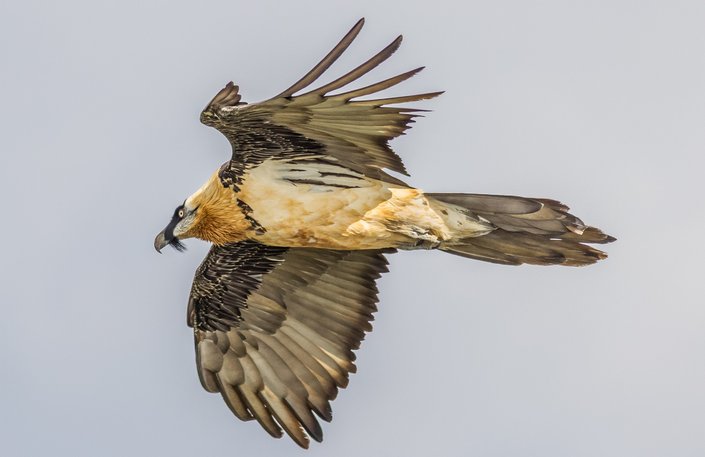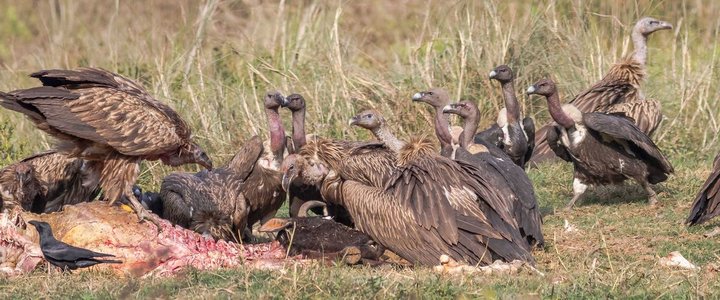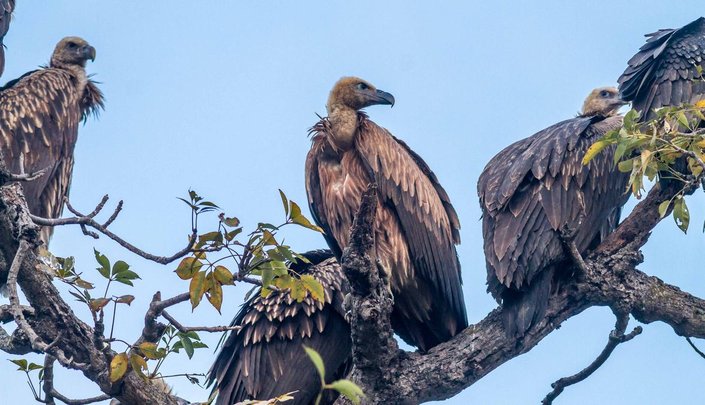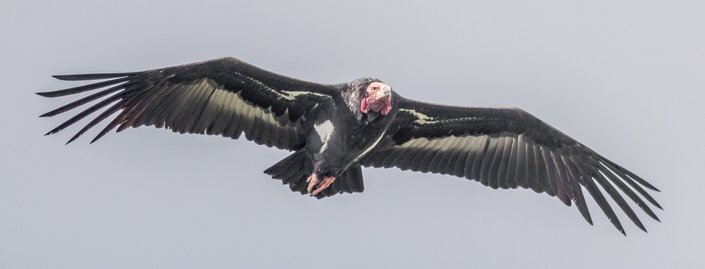An overview of vultures in the world
©Tulsi Subedi
September 2, 2020
Tulsi Subedi
This article highlights the overview of vulture in the world, their importance and conservation. We post this article to raise awareness as a celebration of International Vulture Awareness Day (IVAD) on 5 September 2020.

Among the terrestrial vertebrates, vultures are the most successful and only known obligate scavengers in the world (Ruxton & Houston 2004). Total 23 species of vulture (including condors) represent the wide continental range and they are found in all other continents except in Oceanic and Antarctica. Vulture dwells in the diverse ecosystem and geographical ranges from the Amazonian rainforest to East African savannah, Sahara desert and the Himalayas (Buechley & Sekercioglu 2016). Out of total species, seven are found in North and South America belongs to family Cathartidae. The remaining 16 species are confined to the Old World (Asia, Europe and Africa) belongs to family Accipitridae.
In the New World, Black Vulture (Coragyps atratus) and Turkey Vulture (Cathartes aura) are found in both North and South America. Greater Yellow-headed Vulture (Cathartes melambrotus), Lesser Yellow-headed Vulture (Cathartes burrovianus), Andean Condor (Vultur gryphus) and King Vulture (Sarcoramphus papa) are found only in South America and California Condor (Gymnogyps californianus) found only in North America. Among Old World vultures, four species, Bearded Vulture (Gypaetus barbatus), Cinereous Vulture (Aegypius monachus), Egyptian Vulture (Neophron percnopterus) and Griffon Vulture (Gyps fulvus) are found (or had historical range) in all the three continents (Asia, Europe and Africa). Himalayan Vulture (Gyps himalayensis), Indian Vulture (Gyps indicus), Red-headed Vulture (Sarcogyps calvus), Slender-billed Vulture (Gyps tenuirostris) and White-rumped Vulture (Gyps bengalensis) are found only in Asia. Additional seven species, Cape Vulture (Gyps coprotheres), Hooded Vulture (Necrosyrtes monachus), Rüppell’s Vulture (Gyps rueppelli), White-backed Vulture (Gyps africanus), White-headed Vulture (Trigonoceps occipitalis) and Palm-nut Vulture (Gypohierax angolensis) are found in Africa. The remaining one species, Lappet-faced Vulture (Torgos tracheliotos) is found both in Asia (Middle East only) and in Africa (Mundy et al. 2001).
In the ecosystem, vultures provide a number of services that have direct and indirect benefits to human society. The most important ecosystem service provided by them is the cleaning of the environment by rapid removal or consumption of dead animal carcasses (Markandya et al. 2008; Pain et al. 2003; Sekercioglu 2006; Wenny et al. 2011; Whelen et al. 2008). Benefits from this service include the reduction of carcass disposal cost, enhance the quality of environment due to rapid consumption of filthy carcasses, reduces the chances of spreading disease epidemics and hence provide economic benefits by reducing the cost of disease control/cure (Markandya et al. 2008).

Despite the ecosystem services they provide, vultures are the highly-threatened group of species in the world (Ogada et al. 2012). Habitat loss and degradation, change on land-use practices, human persecution, poisoning (veterinary drugs, lead and pesticides) are the major threats to vulture species, albeit they vary according to the distribution ranges. In America lead poisoning is a major threat to vulture (Carpenter et al. 2003). In Europe vultures are threatened due to poisoning, collision with the powerlines and wind turbines, hunting and human persecution (Botha et al. 2017; Margalida et al. 2008b; Parvanov et al. 2018). In Africa, carbofuran and strychnine poisoning (Ogada et al. 2016, 2012; Ogada 2014) and illegal trade of the body parts (Buij et al. 2016) are the major threats. In Asia, unintentional poisoning due to the effect of various non-steroidal anti-inflammatory drugs (NSAIDs) used to treat ill domestic livestock (mainly diclofenac) is a key threat (Cuthbert et al. 2016; Fourie et al. 2015; Galligan et al. 2016; Green et al. 2004, 2007; Naidoo et al. 2010; Oaks et al. 2004; Pain et al. 2008). The residue of NSAIDs enters into the vultures’ body after the consumption of dead livestock tissues treated with these drugs that cause renal disease and visceral gout as a result, vultures die due to renal failure (Oaks et al. 2004). Currently, 11 out of 16 species of the Old World are listed as globally threatened (eight species critically endangered and three species endangered) and additional three species are listed as near-threatened in IUCN Red List of Birds (BirdLife International 2018).
Impact of poisoning on vultures is well known in most of the ranges including Asia, Europe and Africa. In the Indian subcontinent diclofenac poisoning on Gyps vulture is well studied which caused near extinction of three species (White-rumped, Slender-billed and Indian Vulture) of Gyps vultures (Cuthbert et al. 2011; Oaks et al. 2004; Pain et al. 2008). Due to the strong evidence of diclofenac poisoning on vulture population, now this drug has been banned in the South Asian countries (Bangladesh, India, Nepal and Pakistan) to use as a veterinary medication (Prakash et al. 2012). Recently other veterinary NSAIDs (aceclofenac, nimesulide, ketoprofen, carprofen, flunixin, and phenylbutazone) are known to have a lethal effect on vultures and other scavenging birds (Cuthbert et al. 2007, 2016; Fourie et al. 2015; Galligan et al. 2016; Sharma 2012).

Construction of energy structures such as high-tension electric transmission lines and wind turbines without proper planning in the habitat ranges have significant threats to all species of vultures and other raptors (Margalida et al. 2008; Pérez-García et al. 2017; Reid et al. 2015), that increases electrocution or collision risk. In recent years, several threats to biodiversity are immerging in relation to human population growth and economic development (Butchart et al. 2010). These human-induced threats include habitat loss due to deforestation, habitat conversion, agriculture activities that cause severe habitat degradation (Botha et al. 2017). Shooting, intentional and unintentional poisoning cases are still known to occur in some parts of Europe (Margalida et al. 2008).

Several conservation organizations and scientists around the world are working hard to conserve these nature’s cleaning crew. By continuing our dedication and passion for the conservation of these top scavenging birds could make a difference. Conservation efforts in Europe, America and some parts of South Asia is already encouraging. Scientist able to bring back the population of California condor in the wild, in Western Europe vulture population is restored, in Nepal and India, it is claimed that the population of three species of Gyps vulture (White-rumped, Slender-billed and Indian Vulture) is moving towards stabilisation. Although these are encouraging news for us, despite conservation efforts carried out population decline in a vast range of Africa still continue, poisoning and persecution cases in Balkan ranges still continue. There is no equal attention for the conservation of all species of vultures in Asian countries as conservation actions are focused only in narrow ranges and for few species. In this sense, there is a need for much-intensified efforts on vulture conservation throughout the ranges, which can be achieved by the collaboration among the conservation scientists/organizations and different stakeholders.

Note: Reference list is not posted intentionally